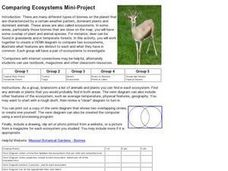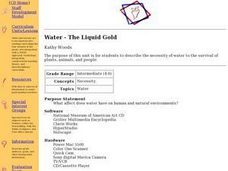Curated OER
Salinity Of Soil
Fourth graders investigate the contents of various types of soil to determine the differences in salinity levels. They conduct an experiment of observing the plants in the different soils. Students then determine survival rates by...
Curated OER
What's Hatching in Kindergarten?
Students identify oviparous animals. They brainstorm a list of animals that lay eggs, read "Chickens Aren't The Only Ones" by Ruth Heller and then add to the list. Students complete a booklet that shows an egg and an oviparous animal.
Curated OER
The Magic School Bus Gets Swamped
Young scholars participate in an experiment that shows them how wetlands filter dirty water. They work in groups to accomplish this experiement with the help of supervisors. A bulletin board can be created to show the plants and animals...
Curated OER
Outdoor Explorations: Mystery Plot Vacant Lot
Students utilize observations skills as they work together in groups to solve a mystery. They discuss and perform strategies to solve mysteries that occurred on a vacant lot. Students use a field guide to identify plants and animals...
Curated OER
Comparing Ecosystems
Students, in groups, research two biomes. They create a Venn diagram and include the characteristics of each biome, placing similar features in the overlapping area of the circles.
Disney
Where Do Brown Bears Live?
What do brown bears in Alaska's Katmai National Park need to survive? Pupils explore the unique habitats, diet, and survival needs of this animal. They predict the consequences of removing any integral part of the bear's survival,...
Mascil Project
Water Quality
How do you prevent the spread of water-borne illness in large public swimming areas? Scholars discover the challenges to identifying safe water through an inquiry experiment. They then produce posters sharing their understanding of water...
Science 4 Inquiry
The Classification of Living Things
It's a classification sensation! Demystify why we classify using an inquiry activity that helps your class sort things out. Groups begin by classifying a variety of shoes before they research organisms and design their own dichotomous...
NOAA
Climate Is Our Friend…Isn’t It?: Make an Extinction Polyhedron
Climate affects populations in different ways. Scholars research extinct organisms and mass extinctions in part three of the 10-installment Discover Your Changing World series. They create graphic organizers, then fill in the...
Curated OER
Prairie In A Bottle
Second graders observe images of prairie ecosystems and discuss the needs of living things. They create a prairie habitat in a closed jar to observe the water cycle and plant growth.
Captain Planet Foundation
Worm Your Way Out of This
How can you provide healthy soil for your garden? Study worms, bacteria, and other microorganisms in a lesson about decomposition and organic compost. After discussing what you know about worms and watching a video, watch what worms do...
Curated OER
Insulation and Buoyancy
Students predict whether their hands be warmer in ice water with or without a blubber mitten. They construct a blubber mitten using plastic, Crisco and compare their results with a control group. They observe how this affects buoyancy too.
Curated OER
Where are the Dinosaurs?
Students understand what it means when an animal is extinct. In this dinosaur lesson, students create dinosaur dioramas showing their habitat and what in their environment might make them become extinct. students pay particular attention...
Curated OER
Do You Need What I Need?
Student identify the basic human needs. In this life science lesson, 3rd graders compare the needs of plants, animals and humans. They apply what they have learned by playing a survival team game.
Creative Educator
Design a Rainforest Postcard
Send your class on an expedition through the rainforest! Along the way, they will write informational postcards to demonstrate what they've learned. Each team will be responsible for one of five rainforest regions. When they return from...
Curated OER
The Columbian Exchange
Eleventh graders examine the significant consequences of Spanish exploration and settlement of the New World on animals, humans, and plants. They read and discuss an informational handout, define key vocabulary terms, and complete a...
Curated OER
What Were Dinosaurs Like?
Students view a video clips about Dinosaurs. In this dinosaur lesson, students begin to understand the extinction of the dinosaurs by comparing them to contemporary animals. Students complete a research sheet on one dinosaur by...
Curated OER
The Columbian Exchange
Tenth graders examine the consequences of Spanish exploration of the New World on animals, humans, and plants. They read and discuss an informational handout, define key vocabulary terms, and complete a Venn Diagram with Old World and...
Curated OER
The Deep
In this deep ocean worksheet, students answer twenty questions after watching a video about the species that live in the deep ocean. Topics include jelly fish, hatchet fish, anglers, tubeworms, sea urchins, and plants that grow in deep...
Curated OER
Graze Like a Cow
Students explore how a cow digests the grass they eat. In this science/math instructional activity, students compare the quality of forage. Additionally, students determine the effects of rangeland health on the production.
Curated OER
What Were Dinosaurs Like?
Students compare and contrast dinosaurs to animals that are alive today through basic research.
Curated OER
environment: Fresh and Saltwater Habitats
Learners compare and contrast fresh and salt water coastal environments. After describing how sea animals adapt to their habitats, they design a variety of sea creatures and explain how the adaptations aid in the animals' survival. ...
Curated OER
Water-The Liquid Gold
Students investigate the necessity of water for the survival of plants, animals, and people. They explore the affect that water has on human and natural environments through literature, field trips, and discussions.
Curated OER
Sponges, Cnidarians, Flatworms, and Roundworms
In this simple animals worksheet, learners read information about sponges, cnidarians, flatworms, and roundworms and then complete a chart comparing and contrasting these groups of animals. This worksheet has 11 fill in the blank questions.

























